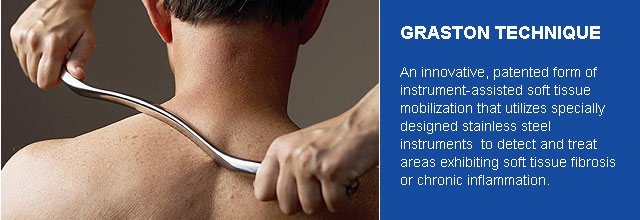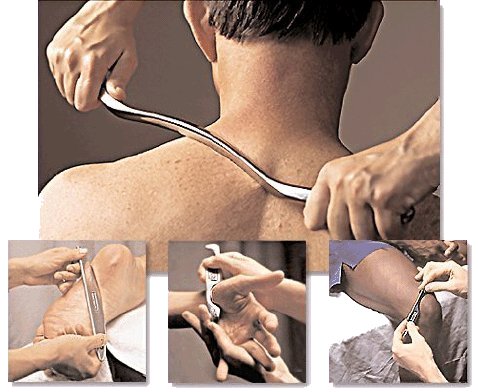The Graston Technique at Better Bodies Chiropractic and Wellness
The Graston Technique is a state-of-the-art technique designed to treat acute and chronic soft tissue conditions and injuries.
The Graston technique is an innovative, patented soft-tissue mobilization technique in which the doctor uses specially designed stainless steel instruments to break up scar tissue and myofascial adhesions.

The Graston technique offers many advantages and benefits.
- Faster rehabilitation recovery
- Resolves chronic conditions thought to be permanent
- Reduces the need for anti-inflammatory medication
- Reduces overall treatment time
- Continue to engage in everyday activities
Six Stainless Steel Instruments Are the Foundation of the Graston Technique
The various curves and edges of the stainless steel instruments allow the doctor to specifically treat the patient’s problem areas. Each of the six patented instruments have been designed to conform to various contours of the body.
The specialized design and construction of the instruments allow the doctor to actually feel and isolate adhesions and soft tissue restrictions in the injured area with a high level of accuracy.
The Graston Technique enables the doctor to apply direct and specific pressure to the problem area with a high level of accuracy using the instruments’ beveled edges. This allows the doctor to use minimal pressure and provides maximum comfort to the patient while the treatment is being administered.
Drs. Jeff and Ginger Foddrell are certified to practice Graston Technique.
How the Graston Technique Works
The Graston Technique is an innovative, patented form of instrument-assisted soft tissue mobilization that enables clinicians to effectively breakdown scar tissue and fascial restrictions. The Technique utilizes stainless steel instruments designed specifically to detect and effectively treat areas with soft tissue fibrosis or chronic inflammation.
The Graston Technique is effective because it provides controlled microtrauma to the affected soft tissue structures. The Technique stimulates a local inflammatory response, which leads to remodeling and repair of affected soft tissues. The instruments allow doctors to identify and treat specific areas.
Treatment with the Graston Technique is conducted in association with a rehabilitation program designed to restore patients to their pre-injury level of activity. This is accomplished by implementing a functional progression program, which focuses on imbalances throughout the kinetic chain. Flexibility, strengthening, and muscle re-education are employed to provide optimal results within a minimal number of treatment sessions.
Graston Technique Procedures
The patented Graston Technique Instruments – shaped to fit the contour of the body – are used to assist doctors in locating and then treating injured tissue that is causing pain and restricting motion. Doctors utilize the instruments to apply precise pressure to break up scar tissue, which relieves discomfort and restores normal function.
The curvilinear edge of the patented Graston Technique Instruments combines with their concave/convex shape to mold the instruments to various contours of the body. This design allows for ease of treatment and maximum effectiveness.
The Graston Technique Instruments – much like a tuning fork – resonate in the doctor’s hands, allowing the doctor to isolate adhesions and restrictions and treat them precisely. As the metal surface of the instruments does not compress, deeper restrictions can be accessed and treated. When explaining the properties of the instruments, we often use the analogy of a stethoscope. Just as a stethoscope amplifies what the human ear can hear, so do the instruments increase significantly what the human hands can feel.
It is common to experience minor discomfort during the procedure and some bruising afterwards. This is a normal response and part of the healing process.
Graston Technique has become standard protocol in universities and hospital-based outpatient facilities, including on-site treatment settings such as Indiana University and the University of Michigan. The Technique is also being used by many industries and by NBA, NHL, and Major League Baseball trainers.
Who Can Benefit from the Graston Technique
Individuals who are experiencing pain and loss of motion and function following surgery, injury, cumulative trauma disorders, repetitive stress syndromes, and tendinitis may benefit from the Graston Technique. Some musculoskeletal disorders which have responded well to the Graston Technique include
- Rotator Cuff Tendinitis (shoulder)
- Lateral Epicondylitis (tennis elbow)
- Medial Epicondylitis (golfer’s elbow)
- Carpal Tunnel Syndrome (wrist pain)
- Patellofemoral Disorders (knee pain)
- Shin Splints
- Achilles Tendinitis (ankle pain)
- Plantar Fasciitis (foot and arch pain)
- Cervical Sprain/Strain (neck pain)
- Lumbar Sprain/Strain (lower back pain)
- Trigger Points
- Scars
- Adhesions
- Tendinitis
- Muscle Pulls
- Muscle Spasms
- Restrictions
- Fibromyalgia
Frequency of Treatment
Patients usually receive two treatments per week for a period of 4 to 5 weeks. Most patients have a positive response by the 3rd or 4th treatment.


